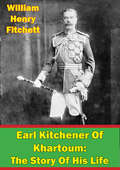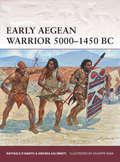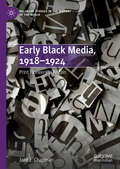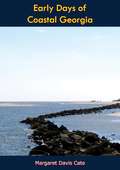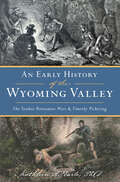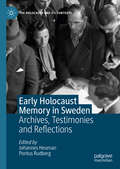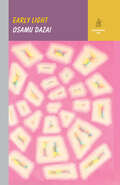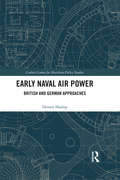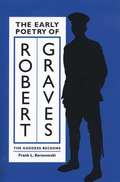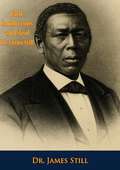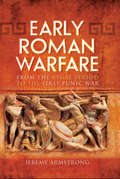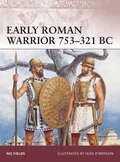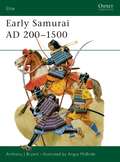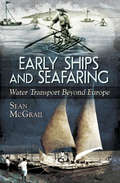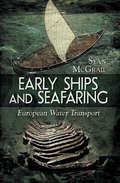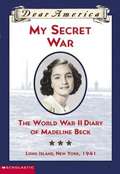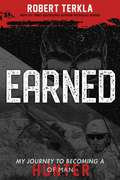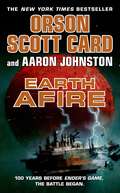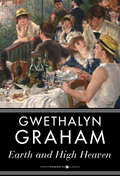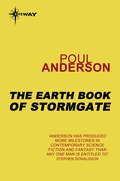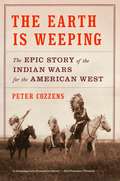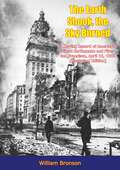- Table View
- List View
The Earl J. Hess Fortifications Trilogy, Omnibus E-book
by Earl J. HessThis three-volume Omnibus e-Book set is a collection of Earl J. Hess's definitive works on trench warfare during the Civil War. The set includes:Field Armies and Fortifications in the Civil War: The Eastern Campaigns, 1861-1864, covering the eastern campaigns, from Big Bethel and the Peninsula to Chancellorsville, Gettysburg, Charleston, and Mine Run;Trench Warfare under Grant and Lee: Field Fortifications in the Overland Campaign, covering Wilderness, Spotsylvania, North Anna, Cold Harbor, and Bermuda Hundred; andIn the Trenches at Petersburg: Field Fortifications and Confederate Defeat, recounting the strategic and tactical operations in Virginia during the last ten months of the Civil War, when field fortifications dominated military planning and the landscape of battle.This invaluable trilogy is a must have for anyone interested in the battles, tactics and strategies of both sides during the Civil War.
Earl Kitchener Of Khartoum: The Story Of His Life [Illustrated Edition]
by Walter JerroldIncludes 8 illustrations.Field Marshal Horatio Kitchener, 1st Earl of Khartoum still stands as one of the great generals produced by Britain. His career was marked by great deeds, and great controversies. The son of a military family, he trained at the Royal Military Academy in Woolwich before his first trip to the Middle East surveying in Palestine in 1874. He joined the newly formed Egyptian Army in 1883, which was in reality controlled by the British, and embarked on campaign in Sudan. He was part of the failed Gordon relief expedition in 1884, and learned a great deal of the area, its people and the military problems of fighting in the arid desert. By 1892 he was Sirdar, head of the Egyptian army, he was given command of the expedition to crush the self-appointed Mahdi who had taken control of large parts of Sudan. It was during this campaign that he gained public and Royal attention after the victories of Atbara and Omdurman that crushed the revolt of the Mahdi.He served as Lord Robert's second in command during the Boer War and served with distinction and much success, although his institution of concentration camps caused great outrage and awful civilian distress. Perhaps his greatest services were during the First World War, as Secretary of State for War, fashioning a great civilian army to fight the militarised hordes of Germany in France and Flanders. He may have gained even greater fame, but was tragically lost at sea when the H.M.S. Hampshire was torpedoed in 1916.An excellent short biography.
Early Aegean Warrior 5000-1450 BC
by Giuseppe Rava Raffaele D'AmatoThe civilisations of the Greece in the Ancient World have inspired and fascinated throughout European history. The stories of Homer, later reinforced by the pioneering archaeological work carried out by men such as Heinrich Schliemann at Mycenae and Sir Arthur Evans at Knossos, have enabled modern researchers and historians to piece together a rich material culture and reconstruct the mysteries of the Ancient World.The mainland and islands of Greece were extensively settled by peoples moving from Asia Minor in c.5000 BC, while a further wave in c.5000 BC introduced bronze-working to the region. It is form this point on that it is possible to discern a distinct Cycladic or Aegean civilisation, developing at roughly the same time as the Egyptian and Persian civilisations. Further to the south, the Minoan civilisation based on Crete held sway, and this power - along with the Helladic Achaeans to the north gradually swamped the Cycladic civilisation in between.In common with most Bronze Age societies, the culture of the Aegean world was dominated by warfare, with the inhabitants living in organized settlements and small citadels with fortification walls and bulwarks, towers and gates to provide protection against invaders from the sea or internecine conflicts. Using the latest archaeological evidence, this title recreates the world of these peoples through a detailed examination of their material culture.
Early American Wooden Ware & Other Kitchen Utensils
by Mary Earle GouldAn authoritative and comprehensive history of wooden ware, including old New England kitchens, pantry tools, bowls, plates, mortars, buckets, tubs, the early uses of paint, means of identification, and much more.“It would be hard to say how and where the material for this book was gathered. From my childhood I have been interested in early manners, customs, and sayings, and have retained as I have learned. It was natural, then, that wherever I went as a collector I questioned and listened, and no chance remarks slipped by unheeded. A notebook went with me and I began to keep a diary of the happenings of the days….“With many happy memories of places I have visited, of acquaintances I have made, of hospitality shown me by those of an older generation and of interesting correspondence with all parts of the United States, I have written my book.“This enlarged edition has been made possible by more research work and by helpful correspondence from those interested in recording this early history. A few more pieces of wooden ware have come to the museum which now numbers over 1,000 pieces, including the iron fireplace utensils.”—Mary Earle Gould
Early Black Media, 1918–1924: Print Pioneers in Britain (Palgrave Studies in the History of the Media)
by Jane L. ChapmanThis book represents the first systematic attempt to analyse media and public communications published in Britain by people of African and Afro-Caribbean origin during the aftermaths of war, presenting an in-depth study of print publications for the period 1919-1924. This was a period of post-conflict readjustment that experienced a transnational surge in special interest newspapers and periodicals, including visual discourse. This study provides evidence that the aftermath of war needs to be given more attention as a distinctly defined period of post-conflict adjustment in which individual voices should be highlighted. As such it forms part of a continuing imperative to re-discover and recuperate black history, adding to the body of research on the aftermaths of The First World War, black studies, and the origins of diaspora.Jane L. Chapman analyses how the newspapers of black communities act as a record of conflict memory, and specifically how physical and political oppression was understood by members of the African Caribbean community. Pioneering black activist journalism demonstrates opinions on either empowerment or disempowerment, visibility, self-esteem, and economic struggles for survival.
Early Days of Coastal Georgia
by Margaret Davis Cate Orrin Sage WightmanDisappearing historic landmarks preserved for posterity…Tabby houses—slave cabins—doorways and cemeteries that recall the history of the early settlers.A story of the living past.Visible evidence of coastal culture. The Military Era and the Plantation Era—its story and heroes…Oglethorpe—the soldiers of Bloody Marsh—faithful Neptune…Along the arc of the Georgia coast there is a chain of sea islands. Of these, Ossabaw, Saint Catherine’s, Sapelo, Saint Simons, Sea Island, Jekyll, and Cumberland are best known as the Golden Isles.Early Days of Coastal Georgia, which was first published in 1955, presents some of their history, illustrated with vintage photos.Beautifully illustrated throughout with photographs by Orrin Sage Wightman.
Early History of the Wyoming Valley, An: The Yankee-Pennamite Wars & Timothy Pickering
by Kathleen A. EarleWhen Connecticut Yankees began to settle the Wyoming Valley in the 1760s, both the local Pennsylvanians and the powerful native Haudenosaunee (Iroquois) strenuously objected. The Connecticut Colony and William Penn had been granted the same land by King Charles II of England, resulting in the instigation of the Yankee-Pennamite Wars. In 1788, during ongoing conflict, a band of young Yankee ruffians abducted Pennsylvania official Timothy Pickering, holding him hostage for nineteen days. Some kidnappers were prosecuted, and several fled to New York's Finger Lakes as the political incident motivated state leaders to resolve the fighting. Bloody skirmishes, the American Revolution and the Sullivan campaign to destroy the Iroquois all formed the backdrop to the territorial dispute. Author Kathleen A. Earle covers the early history of colonial life, war and frontier justice in the Wyoming Valley.
Early Holocaust Memory in Sweden: Archives, Testimonies and Reflections (The Holocaust and its Contexts)
by Johannes Heuman Pontus RudbergThis book investigates the memory of the Holocaust in Sweden and concentrates on early initiatives to document and disseminate information about the genocide during the late 1940s until the early 1960s. As the first collection of testimonies and efforts to acknowledge the Holocaust contributed to historical research, judicial processes, public discussion, and commemorations in the universalistic Swedish welfare state, the chapters analyse how and in what ways the memory of the Holocaust began to take shape, showing the challenges and opportunities that were faced in addressing the traumatic experiences of a minority. In Sweden, the Jewish trauma could be linked to positive rescue actions instead of disturbing politics of collaboration, suggesting that the Holocaust memory was less controversial than in several European nations following the war. This book seeks to understand how and in what ways the memory of the Holocaust began to take shape in the developing Swedish welfare state and emphasises the role of transnational Jewish networks for the developing Holocaust memory in Sweden.
Early Light (Storybook ND Series #0)
by Osamu DazaiEarly Light gathers three tales by Osamu Dazai, author of the wildly popular No Longer Human Early Light offers three very different aspects of Osamu Dazai's genius: the title story relates his misadventures as a drinker and a family man in the terrible fire bombings of Tokyo at the end of WWII. Having lost their own home, he and his wife flee with a new baby boy and their little girl to relatives in Kofu, only to be bombed out anew. "Everything's gone," the father explains to his daughter: "Mr. Rabbit, our shoes, the Ogigari house, the Chino house, they all burned up," "Yeah, they all burned up," she said, still smiling. "One Hundred Views of Mount Fuji," another autobiographical tale, is much more comic: Dazai finds himself unable to escape the famous views, the beauty once immortalized by Hokusai and now reduced to a cliche. In the end, young girls torment him by pressing him into taking their photo before the famous peak: "Goodbye," he hisses through his teeth, "Mount Fuji. Thanks for everything. Click." And the final story is "Villon's Wife," a small masterpiece, which relates the awakening to power of a drunkard's wife. She transforms herself into a woman not to be defeated by anything, not by her husband being a thief, a megalomaniacal writer, and a wastrel. Single-handedly, she saves the day by concluding that "There's nothing wrong with being a monster, is there? As long as we can stay alive."
Early Naval Air Power: British and German Approaches (Corbett Centre for Maritime Policy Studies Series)
by Dennis HaslopThis book examines the British and German approach to naval air power, describing the creation and development of the two naval air service organizations and doctrine. This work provides new insights as to how two naval air services were influenced by internal and political interventions, and how each was integrated into the organizational structures of the Royal Navy and the Kaiserlichemarine (KM). Both the Admiralty and the KM made substantial alterations to their organizations and doctrine in the process. Principal air doctrines employed are examined chronologically and the application of operational doctrine is described. While they adopted similar air doctrines, there were differences in operational doctrine, which they addressed according to their different requirements. This book is a comparative study about the development of organization and air power doctrine in the RNAS (Royal Naval Air Service) and the IGNAS (Imperial German Naval Air Service). It investigates public and political interventions and early concepts of air power, placing into context the factors which contributed to how naval theorists came to think about the best means of controlling its working medium, air space. Ultimately, it examines the similarities, and differences, between the RNAS and IGNAS understanding of naval air power, within the broader strategic and theoretical framework of their parent organizations. This book will be of great interest to students of air power, naval power, military history, strategic studies and IR in general.
Early Observations on Possible Defenses by the Emerging Threat Agent Project
by Bruce W. Bennett Pamela L. Gordon Mcrae Smith Jonathan Kaufman James ByrnesAdversaries could acquire emerging chemical and biological (CB) agents years before U.S. defense planners recognize those agents, and many more years before the United States establishes a comprehensive defense against them. Gaps in defenses against chemical and biological weapon agents can pose a serious risk to U.S. military operations. This paper summarizes early expert observations about the threat and possible responses.
The Early Poetry of Robert Graves: The Goddess Beckons
by Kersnowski Frank L.Like many men of his generation, poet Robert Graves was indelibly marked by his experience of trench warfare in World War I. The horrific battles in which he fought and his guilt over surviving when so many perished left Graves shell-shocked and disoriented, desperately seeking a way to bridge the rupture between his conventional upbringing and the uncertainties of postwar British society. In this study of Graves's early poetry, Frank Kersnowski explores how his war neurosis opened a door into the unconscious for Graves and led him to reject the essential components of the Western idea of reality—reason and predictability. In particular, Kersnowski traces the emergence in Graves's early poems of a figure he later called "The White Goddess," a being at once terrifying and glorious, who sustains life and inspires poetry. Drawing on interviews with Graves's family, as well as unpublished correspondence and drafts of poems, Kersnowski argues that Graves actually experienced the White Goddess as a real being and that his life as a poet was driven by the purpose of celebrating and explaining this deity and her matriarchy.
Early Recollections and Life of Dr. James Still
by Dr James StillKnown in the Medford area as "doctor", James Still was not a licensed physician. The title was conferred by grateful patients who welcomed his gentle remedies after the "heroic" treatment prescribed by most nineteenth-century doctors. Purging and blood-letting were common practice and medication was intended to produce violent results. Blisters, cupping, leeches, and tobacco injections were still used. No wonder suffering patients preferred the vegetable preparations and cooling liniments of Dr. Still. Times were ripe for practitioners such as Dr. Still. Medicine was in transition, and doctors were questioning the use of massive doses of drugs such as calomel and opium. With common sense and caution Dr. Still steered a middle course between the harsh measures of the time. His reputation for cures spread and his practice prospered. [Originally published in] 1877 [this] autobiography and details how he rose from a background of humble means and limited education to success in the medical field.-Print ed.
Early Roman Warfare: From the Regal Period to the First Punic War
by Jeremy ArmstrongWhile copious amounts have been written about the Roman army, most study has focussed on the later Republic or the Imperial period when the legionary system was already well-developed. Here Dr Jeremy Armstrong traces the development of Rome's military might from its earliest discernible origins down to the First Punic War. He shows how her armies evolved from ad-hoc forces of warriors organized along clan lines and assembled for the city's survival, to the sophisticated organization of the legions that went on to dominate all of Italy and then (after the period covered) the entire Mediterranean world. The author reviews both the literary sources and the latest archaeological evidence to provide a fresh analysis of Roman military organization, equipment, tactics and strategy. He shows how Rome's military apparatus adapted to meet the changing strategic needs of new enemies and broader ambitions. This study of the origins of the Classical world's most formidable war machine will be welcomed by anyone with an interest in Classical, and especially Roman, military history.
Early Roman Warrior 753-321 BC
by Sean O'Brogain Nic FieldsThe prototypical 'Roman Legionnaire' often seen on television and in movies is actually the product of nearly a millennium of military development. Far back in the Bronze Age, before the city of Rome existed, a loose collection of independent hamlets eventually formed into a village. From this base, the earliest Roman warriors launched cattle raids and ambushes against their enemies. At some point during this time, the Romans began a period of expansion, conquering land and absorbing peoples. Soon, they had adopted classical Greek fighting methods with militia forming in phalanxes. This book covers the evolution of the earliest Roman warriors and their development into an army that would eventually conquer the known world.From the Trade Paperback edition.
Early Samurai AD 200-1500
by Angus Mcbride Anthony BryantWar played a central part in the history of Japan. Warring clans controlled much of the country. The wars were usually about land, the struggle for control of which eventually gave rise to perhaps the most formidable warriors of all time: the Samurai. Ancient Yayoi warriors developed weapons, armour and a code during the ensuing centuries that became the centrepiece for the Japanese Samurai. Anthony Bryant chronicles the history, arms and armour of these truly élite warriors, from the rise of the Yayoi through the Genpei War (1180-1185) between the Minamoto and Taira clans, to the Mongol invasions of the 13th century.
Early Ships and Seafaring: Water Transport Beyond Europe
by Seán McGrailIn this volume Professor Sen McGrail introduces the reader to a relatively new branch of Archaeology the study of water transport how early rafts, boats and ships were built and used. Concepts, such as boatbuilding traditions, ship stability and navigation without instruments, are first described. Archaeological research is then discussed, including sea levels in earlier times, how to distinguish the vestigial remains of a cargo vessel from those of a fighting craft; and the difference between a boat and a ship.Chapters 2 and 3, the heart of the text, deal with the early water transport of the Mediterranean and Atlantic Europe, from the Stone Age to Medieval times. Each chapter includes a description of the region's maritime geography and an exposition of its boat-building traditions. The third element is a discussion of the propulsion, the steering and the navigation of these early vessels.The sparse, often jumbled, remains of excavated vessels have to be interpreted, a process that is assisted by consideration of early descriptions and illustrations. Studies of the way traditional builders of wooden boats ply their trade today are also a great help. Experimental boat archaeology is still at an early stage but, when undertaken rigorously, it can reveal aspects of the vessel's capabilities. Such information is used in this volume to further our understanding of data from boat and ship excavations, and to present as coherent, comprehensive and accurate a picture as is now possible, of early European boatbuilding and use.
Early Ships and Seafaring: European Water Transport
by Seán McGrailEarly Ships and Seafaring: Water Transport Within Europe' builds on Professor Sen McGrail's 2006 volume 'Ancient Boats and Ships' by delving deeper into the construction and use of boats and ships between the stone age and AD1500 in order to provide up to date information. Regions covered will include the Mediterranean and Atlantic Europe.This interesting volume is easily accessible to those with little t no knowledge of the building and ises of boats, whether ancient or modern. Sen McGrail introduces the reader to this relatively new discipline through the theory and techniques used in the study of early boats as well as the many different types of evidence available to us, including archaeological, documentary, iconographic, experimental and ethnographic, and the natural, physical laws.
Early Sunday Morning: The Pearl Harbor Diary of Amber Billows (Dear America)
by Barry DenenbergDiary of Amber Billows from the World War II era. Part of the Dear America series.
Earned: My Journey to Becoming a Hunter of Man
by Robert Terkla Nicholas IrvingFrom a misguided childhood and the loss of a father battling cancer, to a hunter of man. Former US army sniper deployed to Afghanistan, now Youtube and social media influencer Robert Terkla takes his readers on his path to becoming a sniper and what it took to get there.
Earth Afire
by Orson Scott Card Aaron JohnstonOne hundred years before Ender's Game, the aliens arrived on Earth with fire and death. This is the story of the First Formic War. Victor Delgado beat the alien ship to Earth, but just barely. Not soon enough to convince skeptical governments that there was a threat. They didn't believe that until space stations and ships and colonies went up in sudden flame. And when that happened, only Mazer Rackham and the Mobile Operations Police could move fast enough to meet the threat. Fans of Ender's Game will thrill to Orson Scott Card and Aaron Johnston's Earth Afire.
Earth and High Heaven (Cormorant Classic Reprint Ser.)
by Gwethalyn GrahamDuring the summer of 1942, at a time when the world was already embroiled in the Second World War, twenty-eight-year-old Erica Drake meets Marc Reiser at a garden party. Though the two develop an interest in one another from the start, a seemingly insurmountable rift exists between them—Erica is a Gentile, while Marc is Jewish. However, as their attachment to one another deepens, they soon choose to face the disapproving arguments of their parents as well as their own prejudices.Earth and High Heaven was one of the most highly acclaimed and popular books of its time. Published at the end of the Second World War, it won the Governor General’s Award and was the first Canadian novel to reach number one on The New York Times Bestseller list.HarperPerennial Classics brings great works of literature to life in digital format, upholding the highest standards in ebook production and celebrating reading in all its forms. Look for more titles in the HarperPerennial Classics collection to build your digital library.
The Earth Book of Stormgate: A Polesotechnic League Book (POLESOTECHNIC LEAGUE)
by Poul Anderson'Behold these annals from the Discovery and on through the World-Taking.This is the tale as told by Terrans, who walk the earth.Then read.'THE EARTH BOOK OF STORMGATE POUL ANDERSON'S MIGHTY EPIC OF FUTURE HISTORYThe full length story forming the core of the chronicle of the expansion of earthmen into the inhabited galaxy . . . from the Earth Book kept in the Stormgate archive of the great winged race of Ythri.
The Earth Is Weeping: The Epic Story of the Indian Wars for the American West
by Peter CozzensBringing together a pageant of fascinating characters including Custer, Sherman, Grant, and a host of other military and political figures, as well as great native leaders such as Crazy Horse, Sitting Bull, Geronimo, and Red Cloud, The Earth is Weeping—lauded by Booklist as “a beautifully written work of understanding and compassion”—is the fullest account to date of how the West was won…and lost."[S]ets a new standard for Western Indian Wars history..." —Stuart Rosebrook, True West MagazineWith the end of the Civil War, the nation recommenced its expansion onto traditional Indian tribal lands, setting off a wide-ranging conflict that would last more than three decades. In an exploration of the wars and negotiations that destroyed tribal ways of life even as they made possible the emergence of the modern United States, Peter Cozzens gives us both sides in comprehensive and singularly intimate detail. He illuminates the encroachment experienced by the tribes and the tribal conflicts over whether to fight or make peace, and explores the squalid lives of soldiers posted to the frontier and the ethical quandaries faced by generals who often sympathized with their native enemies.
The Earth Shook, the Sky Burned: A Moving Record of America’s Great Earthquake and Fire: San Francisco, April 18, 1906 [Illustrated Edition]
by William BronsonThe Earth Shook, The Sky Burned is the dramatic, complete account of the San Francisco earthquake of April 18, 1906. In the early morning of that day, the sleeping city was rocked by a violent earth tremor that ravaged buildings, heaved streets, and terrified drowsy residents. But worse was to come: the devastating fire that swept across the city for three days. Nearly 30,000 structures were destroyed, and over a quarter million people were left homeless.The Earth Shook, The Sky Burned is a blow-by-blow account of the four days of devastation, not only in San Francisco, but in its adjacent communities. Among the huge cast are Enrico Caruso, who vowed never to return after the quake; John Barrymore, reportedly shaken from a tryst with a young actress; General Frederick Funston, who directed attempts to halt the spreading fire; and Amadeo Giannini, who saved the Bank of Italy’s gold reserves in his horsecart and founded Bank of America after the fire.Illustrated with over 400 on-the-scene photographs, this memorable book reflects the indomitable spirit and vigor of the people who built the West.“Bronson covers every aspect of the disaster in lucid sinewy prose and the selection of a brilliant gallery of pictures…This must rank as the most moving and comprehensive account of the great disaster ever published.”—Los Angeles Times“A fascinating book, and the pictures are magnificent.”—Chicago Sunday Tribune“The Earth Shook, The Sky Burned will make you quake in your boots. The extraordinary story that began on April 18, 1906, has never been told better than what you will find between these covers.”—Michael McCone, Executive Director, The California Historical Society

